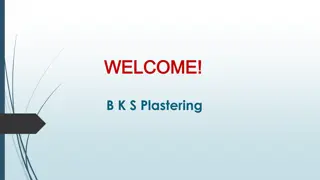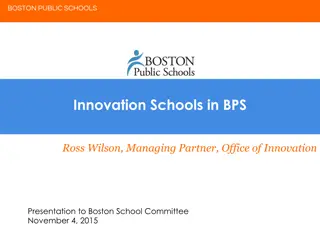Evaluation System in Italian Schools: A Comprehensive Overview
Italy's school evaluation system has recently been established to improve educational quality and provide necessary support. The process involves self-evaluation, improvement actions, external evaluation, and reporting of results. Data from Ministry of Education and INVALSI are utilized, leading to a detailed self-evaluation report and an improvement plan based on collected information.
Download Presentation

Please find below an Image/Link to download the presentation.
The content on the website is provided AS IS for your information and personal use only. It may not be sold, licensed, or shared on other websites without obtaining consent from the author.If you encounter any issues during the download, it is possible that the publisher has removed the file from their server.
You are allowed to download the files provided on this website for personal or commercial use, subject to the condition that they are used lawfully. All files are the property of their respective owners.
The content on the website is provided AS IS for your information and personal use only. It may not be sold, licensed, or shared on other websites without obtaining consent from the author.
E N D
Presentation Transcript
SELF EVALUATION IN THE ITALIAN SCHOOL SYSTEM Training Event 30 January 2017 -3 february 2017 Spain -Madrid
Differently from other european school systems, Italy has only recently started to define an evaluation program both for the general educational system and for single schools
The National Evaluation System has different purposes: helping each school to keep under control its own provided education and do its best for improving the control on the quality of it providing the Ministry of Education with useful information in order to plan supporting actions for the schools that need them evaluating headteachers showing the results of educational action outside school
On the 28th of march 2013, in cooperation with the Minister of Education University and Research, the Council of Ministers approved the act regulating the National System of Evaluation. With this act Italy aligns itself to the other European countries in the field of evaluation of public education systems
Steps in the self evaluation process The process of evaluation is based on four essential steps: a) self evaluation of schools b) improvement actions c) external evaluation from specific boards coordinated by a technical director leading to a revision of schools improvement plans d) public report of the results
SCHOOL SELF EVALUATION It is based on data collected from: databanks of the information system of the Ministry of Education INVALSI (National Institute of Evaluation of Educational System) through periodical monitoring data collected from schools themselves The evaluation ends with a self evaluation report (RAV) and with the elaboration of an improvement plan.
The first three sections of the Self evaluation Report are: Context -Results -Processes. The section Processes is divided in Didactic and educational practices and Managing and organization practices
For each of the three sections (Context, Results and Processes) the Report: - defines the area and gives a certain number of indicators - proposes guide questions and requires to put into evidence opportunities and limits (only for the Context area) - requires to define strong points and weak points (for the section Results and Processes) and defines a general criterion of quality - requires to motivate the self evaluation estimation The fourth section: critical reflections about the self evaluation path The fifth sections requires some choices to be made by schools on the basis of priorities and goals to be achieved through the following Improvement Plan
The context analysis The Context has to be described and not evaluated. The purpose is to allow schools to analyse the characteristics of the reference context and put into evidence limits and opportunities for each area.
The analysis and evaluation of results are very important because the actions of improvement will be based on the critical points highlighted in this section. In the area of school results some elements have a special relevance: - the number of school drop-outs - the comparison with other schools operating in the same conditions - the students success at the end of their studies, in the following training paths and in the work field (Distance results)
Evaluation of processes To analyse and evaluate processes, it is important to consider the quality and quantity of the informations available for the school Pinpoint priorities General goals that the schools wants to attain on the long term
Defining process aims These are operational objectives to be achieved on the short term (a school year) and they concern one or more process areas The objectives must be a limited number and have to be defined coherently with the context situation and with the available resources .
IMPROVEMENT ACTIONS The improvement actions are contained in the Improvement Plan (PDM), a document integrating the Three years Plan for Educational offering (PTOF) of each school. Since school year 2015/2016 every school has to produce an improvement plan in order to achieve the goals related to the priorities of the Self Evaluation Report
What is improvement? Improvement is the process that the school undertakes in order to: increase the learning level of the students the quality of Education Offer bring innovation in the learning environment
Structure of the Improvement Plan Il PDM prevede le seguenti sezioni: Reference background and context analysis Guidelines of the Improvement Plan referred to the Results area and Processes area Analysis of Possibility of action and Impact Main strategies of the Plan and indicators of process Projects that are coherent with the strategic points of the plan
Characteristics of the Improvement Plan (PDM) A good Improvement Plan must: pinpoint the expected results and the time span (short term: 1 school year; long term: 2 or 3years) Establish the actions to be undertaken using indicators that must be observable and measurable in order to allow a periodical monitoring Describe the activities on which actions are to be taken and the subjects that are involved
Revision of the Improvement Plan The Improvement Plan is strictly connected with the Educational Offering Plan, being part of it . The Improvement Plan is updated every year after: Revision of the Self evaluation Report (RAV) Self evaluation of the school concerning the monitoring of projects included in the Educational Offering Plan feedback of the results obtained in National Tests about Italian and Mathematics Inspection of the Board of External Evaluation
EXTERNAL EVALUATION The External Evaluation is oriented towards school Improvement . It is carried on by the Board for External Evaluation The Board consists of three members: Technical Director of Ministry of Education Professional operator from the school sector (headteacher or teacher) Expert coming from outside the school sector with experience in social and evaluation research
Tasks of the Board of External Evaluation The external evaluation consists of three steps: before visiting the school,the Board of External Evaluation analyzes documents and data during the inspection, there is a further gathering of data and informations through interviews, documents analysis and observation of spaces after the inspection, the board formulate a motivated judgement about the school, writes the external evaluation report and gives the results to the school; these results will be used by the school to update and revise the Improvement Plan.
PUBLIC REPORT The success of the Educational Offering Plan, of the Improvement Plan and of the self evaluation process is connected with the involvement of the whole school community. Sharing and dissemination activities take place through periodical reports monitoring of projects and dissemination of results among school collective bodies ( Teachers Council, class councils, parents assemblies) internal communications publication of documents in the official school register information through the official web site
Or tu chi se, che vuo sedere a scranna, per giudicar di lungi mille miglia con la veduta corta d una spanna? Dante Alighieri, Paradiso, canto XIX, 79-81
This work is licensed under a Creative Commons Attribution-NonCommercial 4.0 International License.























